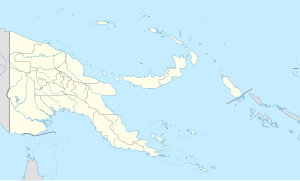Schwimmer Airfield
| Schwimmer Airfield 14-Mile Drome 
|
|
|---|---|
| Part of Fifth Air Force | |
|
Located near Port Moresby, Papua New Guinea |
|
| Coordinates | 09°22′25.56″S 147°13′56.82″E / 9.3737667°S 147.2324500°E |
| Type | Military airfield |
| Site information | |
| Controlled by | United States Army Air Forces |
| Site history | |
| Built | 1944 |
| In use | 1944 |
Located near Port Moresby, Papua New Guinea
Schwimmer Airfield (also known as 14-Mile Drome) is a former World War II airfield near Port Moresby, Papua New Guinea. It was part of a multiple-airfield complex in the Port Moresby area, located north of the Laloki River.
The airfield was known as 14 mile for its distance from Port Moresby, and also known as 'Laloki' or 'Lakoki Drome' for the river to the northwest of the airstrip. It was officially renamed "Schwimmer Airfield" on November 10, 1942, in honor of Charles Schwimmer, lost in P-39D 41-6956 intercepting Japanese aircraft over Port Moresby.
Schwimmer Airfield was built by the US Army in early 1942 with a single runway 5,300 feet (1,600 m) long and 100 feet (30 m) wide. Around October 1942 it was re-surfaced with Marston Matting. No revetments were built but the taxiway and parking areas were dispersed to the north of the runway in a semicircle. The crews lived in pyramid tents .5 miles (0.80 km) from the strip in scrub trees.
Many units were rotated in and out of the airfield during its use. Major units assigned were:
The airfield was closed after the war and today there is little evidence remaining of the facility. Houses have been built along much of the former runway area. The rest is overgrown and abandoned. Some wartime debris litter the area. Bomb storage bays are visible from the road.
![]() This article incorporates public domain material from the Air Force Historical Research Agency website http://www.afhra.af.mil/.
This article incorporates public domain material from the Air Force Historical Research Agency website http://www.afhra.af.mil/.
...
Wikipedia

